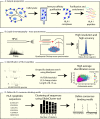Mass spectrometry of human leukocyte antigen class I peptidomes reveals strong effects of protein abundance and turnover on antigen presentation
- PMID: 25576301
- PMCID: PMC4349985
- DOI: 10.1074/mcp.M114.042812
Mass spectrometry of human leukocyte antigen class I peptidomes reveals strong effects of protein abundance and turnover on antigen presentation
Abstract
HLA class I molecules reflect the health state of cells to cytotoxic T cells by presenting a repertoire of endogenously derived peptides. However, the extent to which the proteome shapes the peptidome is still largely unknown. Here we present a high-throughput mass-spectrometry-based workflow that allows stringent and accurate identification of thousands of such peptides and direct determination of binding motifs. Applying the workflow to seven cancer cell lines and primary cells, yielded more than 22,000 unique HLA peptides across different allelic binding specificities. By computing a score representing the HLA-I sampling density, we show a strong link between protein abundance and HLA-presentation (p < 0.0001). When analyzing overpresented proteins - those with at least fivefold higher density score than expected for their abundance - we noticed that they are degraded almost 3 h faster than similar but nonpresented proteins (top 20% abundance class; median half-life 20.8h versus 23.6h, p < 0.0001). This validates protein degradation as an important factor for HLA presentation. Ribosomal, mitochondrial respiratory chain, and nucleosomal proteins are particularly well presented. Taking a set of proteins associated with cancer, we compared the predicted immunogenicity of previously validated T-cell epitopes with other peptides from these proteins in our data set. The validated epitopes indeed tend to have higher immunogenic scores than the other detected HLA peptides. Remarkably, we identified five mutated peptides from a human colon cancer cell line, which have very recently been predicted to be HLA-I binders. Altogether, we demonstrate the usefulness of combining MS-analysis with immunogenesis prediction for identifying, ranking, and selecting peptides for therapeutic use.
© 2015 by The American Society for Biochemistry and Molecular Biology, Inc.
Figures






References
-
- Mouchess M. L., Anderson M. (2014) Central tolerance induction. Curr. Top. Microbiol. Immunol. 373, 69–86 - PubMed
-
- Yun J., Adam J., Yerly D., Pichler W. J. (2012) Human leukocyte antigens (HLA) associated drug hypersensitivity: consequences of drug binding to HLA. Allergy 67, 1338–1346 - PubMed
-
- Dierselhuis M., Goulmy E. (2009) The relevance of minor histocompatibility antigens in solid organ transplantation. Curr. Opin. Organ Transplant. 14, 419–425 - PubMed
-
- Neefjes J., Jongsma M. L., Paul P., Bakke O. (2011) Towards a systems understanding of MHC class I and MHC class II antigen presentation. Nat. Rev. Immunol. 11, 823–836 - PubMed
Publication types
MeSH terms
Substances
LinkOut - more resources
Full Text Sources
Other Literature Sources
Molecular Biology Databases
Research Materials

